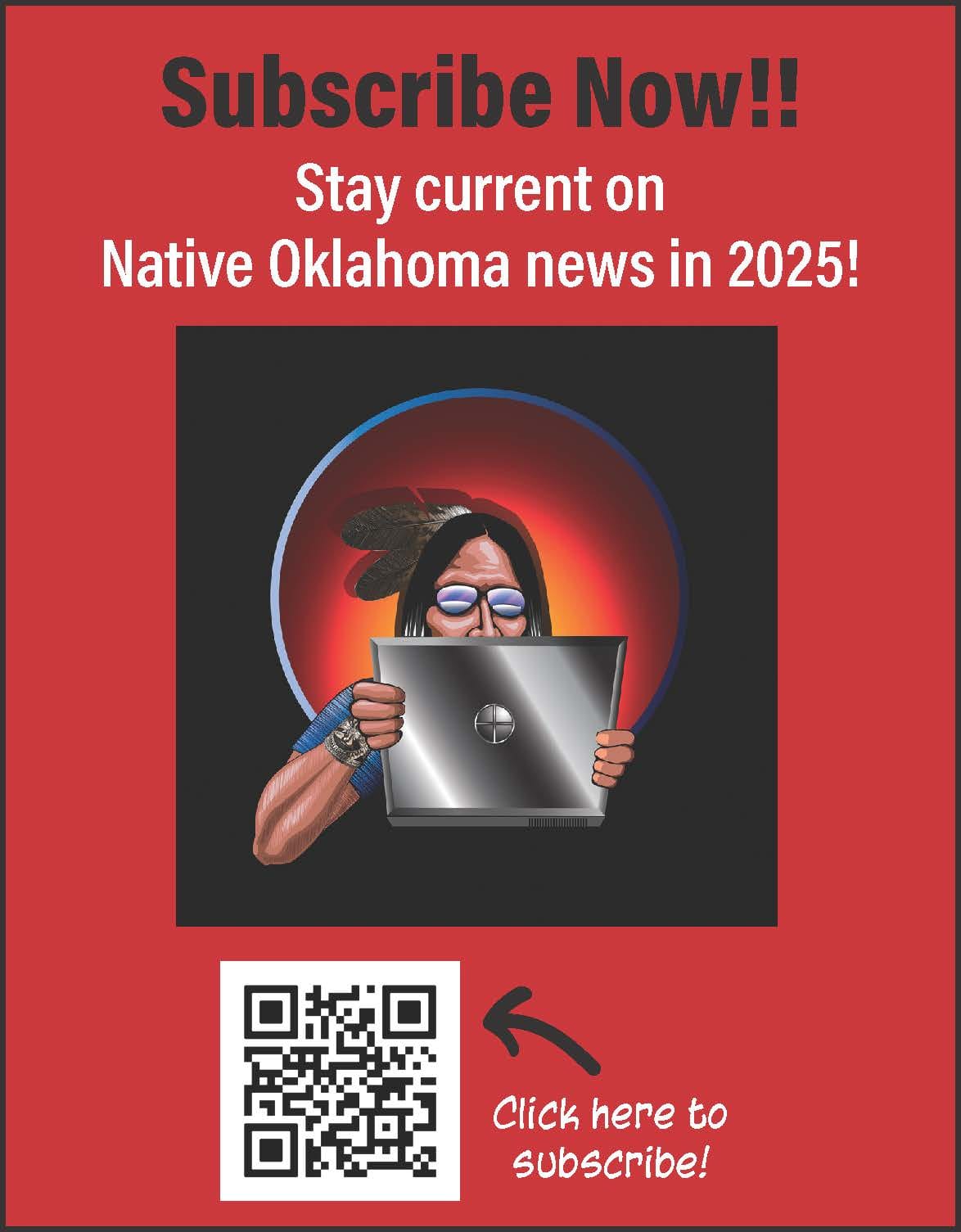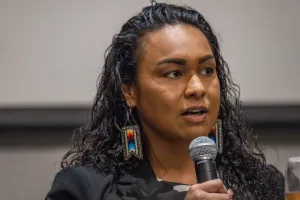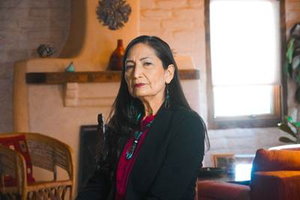

Muscogee Nation, Osage Nation, and Quapaw Nation Expression of Unified Approach to Resolving Tobacco Compact Issue with the State of Oklahoma
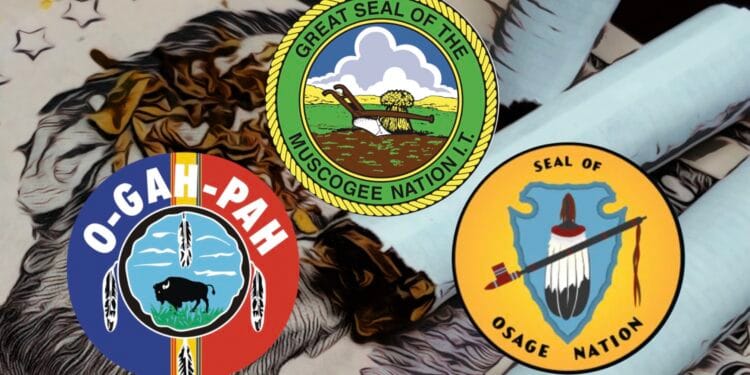
by Jerrad Moore, Mvskoke Media
MVSKOKE RESERVATION — Leaders from the Muscogee (Creek) Nation, Osage Nation, and Quapaw Nation (the “Nations”) have committed to collaborate and seek positive action from the State of Oklahoma on tobacco tax compacts. To date, the Nations have not been able to reach tobacco tax compacts in negotiations with Governor Stitt. Nation leaders have committed to seeking a resolution to tobacco tax issues through the State Legislature. In doing so, the Nations are guided by the following three principles:
1. First Things First. Nation leaders believe that reaching agreement on tobacco compacts is an important first step to other cooperative discussions with State leaders. Each of these issues should be considered as separate issues with consideration on the merits of each one, not used as a way to strong arm the Nations. Nation leaders are committed to meaningful conversations with the
State regarding the Oklahoma turnpikes that travel through Tribal lands and Nation motor vehicle tag issues, but only after a successful resolution of the tobacco compact.
2. Respect. Nation leaders seek respectful dealings with State leaders to resolve issues that impact Tribal and non-Tribal citizens of Oklahoma. Nation leaders agree to come to the table with State leaders with respect and serious focus on reaching mutually-acceptable outcomes. The Nations must be respected and treated as independent, sovereign governments – each with unique concerns and
responsibilities within their communities. This includes the vital ability of each Nation to support public safety, economic development, and essential services for both tribal citizens and surrounding communities. The Nations look forward to working with the Legislature on a true government-to-government basis to meet these shared objectives.
3. Good Faith. Nation leaders and representatives have spent months in good faith negotiations with the Governor for a tobacco compact. With no resolution, Nation leaders now seek legislation that would accomplish a fair agreement with the State. The Nations’ leadership and legal teams will continue to remain in contact with the State of Oklahoma, committed to reaching a solution that provides long-term clarity and stability to Tribal communities, supports business owners, the people of Oklahoma, and the economic well-being of the entire state.
The U.S. Forest Service and American Indian Alaska Native Tourism Association Select Recipients for FY 24 NATIVE Act Grants
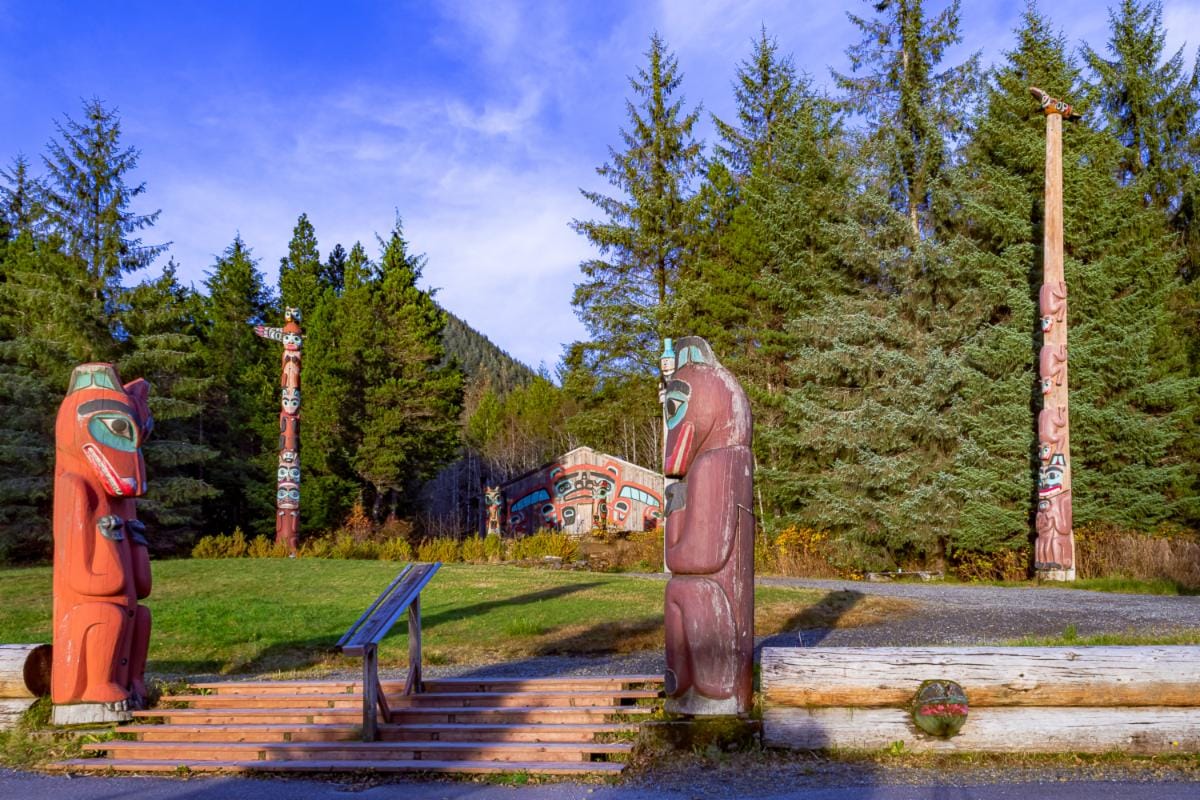
ALBUQUERQUE, N.M. – The American Indian Alaska Native Tourism Association (AIANTA), in partnership with the U.S. Forest Service, has made its selection for the awardees of the USDA Forest Service/AIANTA NATIVE Act Grants for FY24. Six project proposals will receive NATIVE Act funding support to aid their efforts to enhance cultural tourism and recreation for the advancement of Native American communities.
In 2018, AIANTA entered into a Memorandum of Understanding with the U.S. Forest Service to collaborate on NATIVE Act activities, and, subsequently, in 2022 entered into a partnership agreement to strengthen tribal tourism through financial and technical assistance. The FY24 Request for Grant Proposals solicited applications from Tribal Nations, Tribal Enterprises and native nonprofits that border and/or have historic ties to U.S. Forest Service managed lands and regions.
The selected project proposals were chosen to develop infrastructure and/or capacity in Native communities within a two-year time span. The USDA Forest Service/AIANTA NATIVE Act Grantees are as follows:
- Cape Fox Cultural Foundation in Ketchikan, AK Grant Award: $187,462 Project Name: Saxman Totem Park Restoration
- Catawba Indian Nation Cultural Services Division in Rockhill, SC Grant Award: $100,000 Project Name: Mánuu kúrii (Good Earth)
- Chugach Regional Resources in Anchorage, AK Grant Amount: $226,240 Project Name: Ilakuilluki “to share with them” Project
- Shoshone Paiute Tribes of the Duck Valley Indian Reservation in Owyhee County, IDGrant Award: $224,606 Project Name: Togugunde (Heavens - pronounced - Do-go-gun-duth) Observatory
- Tlingit Haida Central Tribal Council in Juneau, AK Grant Award: $54,751 Project Name: Co-Stewardship Totem Pole Carving Shed Project
- Wrangell Cooperative Association (WCA) in Wrangell, AK Grant Award: $250,000 Project Name: Shtaxʼhéen Ḵwáan Totem Restoration Project
For more than 26 years, AIANTA has worked to address inequities in the tourism system and has served as the national voice for American Indian, Alaska Native and Native Hawaiian nations engaged in cultural tourism, while providing technical assistance, training and capacity building to Native Nations and communities and Indigenous-owned enterprises engaged in tourism, hospitality, and recreation.
“This collaboration between AIANTA and the USDA Forest Service, culminating in these NATIVE Act grants, underscores our shared commitment to empowering U.S. Native Nations and communities through cultural tourism,” said AIANTA CEO Sherry L. Rupert. “These grants will provide tangible resources for infrastructure and capacity building, fostering sustainable economic growth while preserving and celebrating the rich heritage of these Indigenous entities. We are excited to see these six recipients transform and strengthen their cultural tourism programs over the next few years.”
First introduced by Senator Brian Schatz (D-HI) in 2015, the Native American Tourism & Improving Visitor Experience (NATIVE) Act gained widespread bi-partisan support before being signed into law in 2016.
The NATIVE Act, or Public Law 114-221, serves to establish a more inclusive national travel and tourism strategy and has the potential to deliver significant benefits for tribes, including jobs creation, elevated living standards and expanded economic opportunities.
In 2019, AIANTA was designated a coordinating partner, and charged with fulfillment of section 4353(d) of the Act, which calls for an “organization or entity to serve as a facilitator between the Secretary of the Interior and the Secretary of Commerce and the Indian tribes, tribal organizations, and Native Hawaiian organizations” in order to “identify areas where technical assistance is needed through consultations” and to “provide a means for the delivery of technical assistance.”
To learn more about the NATIVE Act, visit www.congress.gov.
Tribes who are looking to start or expand their cultural tourism footprint can find resources at www.aianta.org and visitors interested in learning more about Native culture can visit www.nativeamerica.travel.
Weapons expert preps for Artesian Arts Festival
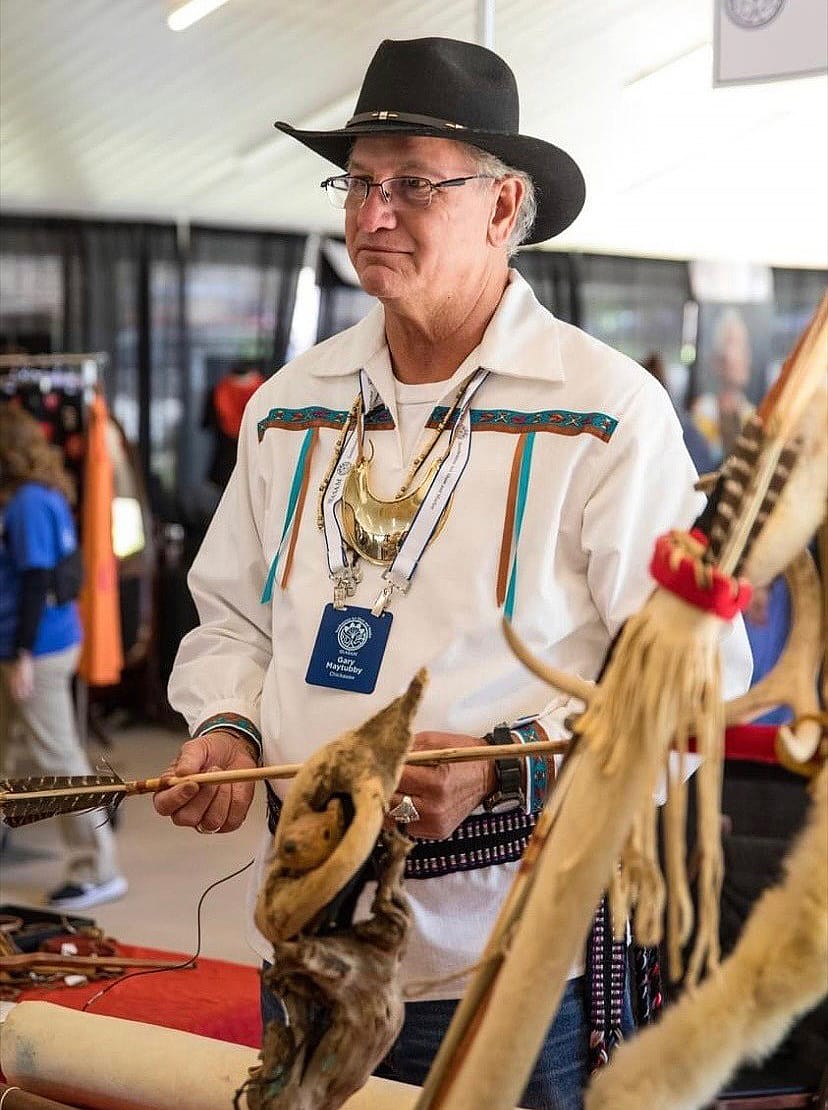
ARDMORE, Okla. – An award-winning artist looks to his immediate family and ancient ancestors to craft weapons almost indistinguishable from how they would have been made centuries ago.
Gary Maytubby, a Chickasaw citizen, is preparing for the 12th annual Artesian Arts Festival.
He will bring war clubs, stone hatchets, arrows, bows, neck knives and more to the show, all inspired by his research into traditional Chickasaw weaponry.
The prestigious First American art show will be conducted in Sulphur, Oklahoma, from 10 a.m. to 6 p.m. June 7. More than 100 First American artists representing many tribal nations will take part in the event.
Maytubby’s artistic journey began at age 7. His Chickasaw uncles would make bows and arrows, and Maytubby soaked up knowledge and techniques he would later use.
Raised in Virginia, Maytubby’s father, Benny, worked for the Pentagon, and the family made trips to Oklahoma every summer to visit family.
“My uncle Melvin made arrows out of a dogwood bush – not the tree, but the bushes growing along fence rows throughout southern Oklahoma. He taught me to pick the red branches because they are straight, strong and just right for crafting. His knowledge helped me tremendously.
“My uncle Byron would make bows from bois d’arc trees. I remember he would run a wire through the fruit of bois d’arc trees (commonly referred to as “horse apples”), string them between trees and that would be our target,” he said. “It was fun, and I learned a lot at the same time.”
He recalls his father manufacturing a tomahawk from a crabapple tree while in Virginia, and it is proudly displayed in his Ardmore home.
The family moved back to the Mill Creek area of the Chickasaw Nation in 1970 when Maytubby’s father retired. While approaching his teenage years, Maytubby’s interest in crafting weapons remained active, but with school and later a full-time job, he did not find the time to devote to it. Maytubby worked 40 years for Chickasaw Telephone Company before retiring in 2019.
“There was a lull of about 10 or so years. When I got back into it there was a strong desire to study and research how ancestral Chickasaws armed themselves for battle and also hunting to sustain the tribe,” Maytubby said.
The family has identified land in the Chickasaw Homeland in Mississippi that once belonged to his great-great-great-grandfather. On that land, flint-knapped arrowheads have been discovered, and photos of them were acquired by Maytubby through his cousin, Lee.
“The arrowheads were photographed with a quarter next to them so you could judge the size. They are about an inch long, triangular-shaped, and I call them a ‘Chickasaw point.’ After seeing this, I make all of my arrows with a Chickasaw point because I know it is authentic,” Maytubby said. “While I may not be the best flint knapper, I do my best to replicate how Chickasaws would have done it back in ancient times.”
While all genres of Maytubby-made weapons are available to art lovers and patrons, he specializes in making arrows, many with stone arrowhead tips.
“All of my arrows are made to be shot,” he said. “I don’t skimp around. I make them to be used.”
Maytubby is aware most people who purchase his arrows probably frame them for their beauty, exceptional craftsmanship and authentic Chickasaw technique. He recently has discovered a place he can harvest river cane – another material frequently used by Chickasaws to craft arrows.
“I remember my uncles telling me my grandfather would acquire sinew from the backstrap of hogs slaughtered in the fall. He would chew it to soften it and make it pliable. He made blunt arrows out of persimmon trees to hunt small game. I am going to make one of those and soon,” he said with enthusiasm.
His research of fletching arrows – applying feathers to the rear so the weapon flies straight and true – fascinates him. If only feathers from the right or left wing are placed on the arrow, it enhances its spin for greater accuracy.
“All of the Southeastern tribes knew this secret, I learned through research,” he said. “Fletching an arrow exclusively with right or left wing feathers improves everything and gives the hunter the best opportunity of success.
“In the 1980s, I was interested in making weapons and remember how my uncles and a group of guys I hung around with were making them. I would say I dabbled crafting weapons, but when I retired, I had time to go full-scale into my art. I was determined to research Chickasaw history, culture and tradition to make them as authentic as possible,” Maytubby said.
Maytubby will enter the juried competition of the Artesian Arts Festival with a war club he made.
Now that he has time and a desire to research ancient crafting, he found a workshop next to his home and spends time improving and developing his art while “staying out of my wife Rebecca’s hair,” he said with a laugh.
For more information about the Artesian Arts Festival, visit ArtesianArtsFestival.com.
